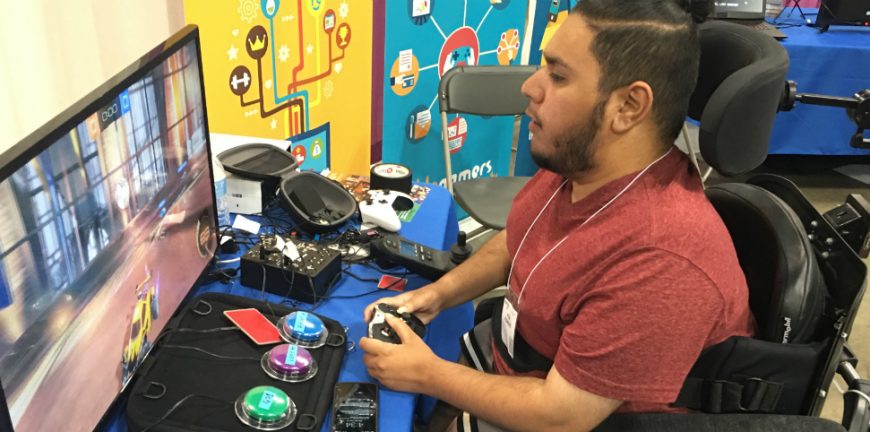Industry Downturn Impacts Game Accessibility Features

Table of Contents
Reduced Development Budgets & Accessibility Features
With tighter budgets, game studios often prioritize core gameplay mechanics over less immediately visible features like accessibility options. This leads to significant cutbacks in accessibility development. The pressure to deliver a profitable product within a constrained budget often means difficult choices, and unfortunately, accessibility features are frequently among the first to be sacrificed.
- Fewer developers allocated to accessibility features: Teams are often streamlined, and specialized accessibility programmers may be the first to be let go or reassigned.
- Reduced testing for accessibility compliance: Thorough accessibility testing requires dedicated time and resources, which are often curtailed during budget cuts. This leads to a higher chance of accessibility bugs and issues going unnoticed.
- Post-launch accessibility patches less frequent or entirely absent: Fixing accessibility issues after launch requires additional development time and resources, making these patches less likely in a cost-cutting environment.
- Prioritization of features with higher perceived player impact: Features that directly influence core gameplay are more likely to be prioritized over accessibility options which, while crucial, may not be immediately obvious to all players.
This prioritization, while understandable from a business perspective, significantly impacts the quality and availability of crucial game accessibility features, ultimately harming the accessibility experience. This also impacts the overall cost of game development, putting further pressure on budget allocation.
Impact on Diverse Player Base
The reduction in accessibility features directly affects players with disabilities, excluding them from fully enjoying the gaming experience. This significantly limits inclusivity within the gaming community. Accessible gaming shouldn't be a luxury; it's a fundamental aspect of inclusive design.
- Players with visual impairments: May struggle without proper audio cues, screen readers, and customizable visual settings like contrast adjustments and text size options. Lack of these features creates a significant barrier to entry.
- Players with motor impairments: May find gameplay impossible without customizable controls, alternative input methods (like eye-tracking), and adaptive controllers. The inability to adapt controls limits participation for many players.
- Players with cognitive impairments: Might need simplified user interfaces (UI), adjustable difficulty levels, and clear, concise instructions. Overly complex menus and rapid gameplay can be overwhelming and exclude a significant portion of the gaming community.
- This exclusionary practice undermines the principles of inclusive game design: Creating games accessible to everyone not only expands the potential audience but also fosters a more welcoming and diverse gaming community.
The impact extends beyond individual players; a less inclusive gaming industry negatively affects the broader social perception of accessibility and disability inclusion.
Long-Term Effects on Game Accessibility Standards
The current situation could set a concerning precedent, potentially slowing down or even reversing progress made in game accessibility. The short-sighted cost-cutting measures today could have far-reaching and damaging long-term consequences.
- Fewer accessible games entering the market: A decrease in investment in accessibility features directly translates to fewer games being developed with these crucial features.
- Less innovation in accessibility technology within games: Reduced funding hinders research and development of innovative accessibility solutions within the gaming space.
- A decline in industry standards regarding accessible game development: The lack of accessible games sets a lower standard for future development, reinforcing a trend of exclusion.
- Reduced advocacy for accessible game development: When accessibility becomes less of a priority in mainstream games, the impetus for industry-wide advocacy for improvement also declines.
Without a concerted effort to reverse this trend, the future of accessible game development looks bleak, potentially excluding millions of potential players.
Potential Solutions & Advocacy
While the situation is challenging, there are actions we can take to mitigate the negative impact and ensure that game accessibility features remain a priority.
- Support indie developers focused on accessible game design: Many smaller studios prioritize accessibility despite limited budgets, and supporting them financially is crucial.
- Advocate for government funding and tax incentives for accessible game development: Governments can play a significant role in incentivizing the creation of accessible games.
- Encourage consumer demand for accessible games through reviews and purchasing decisions: Consumers have the power to influence the market by actively choosing and promoting games that prioritize accessibility.
- Promote discussions and raise awareness about the importance of game accessibility features: Increased awareness leads to greater understanding and demand for inclusive game design.
By taking proactive steps, we can collectively counteract the negative impacts of the economic downturn on game accessibility.
Conclusion
The current economic downturn poses significant challenges to the advancement of game accessibility features. Reduced budgets lead to fewer resources for accessibility development, impacting a large and diverse player base. However, by actively supporting developers committed to inclusivity, advocating for better industry practices, and demanding accessible games as consumers, we can work towards ensuring that everyone can enjoy the joy of gaming. Let's continue to champion game accessibility features, accessible game development, and inclusive game design to ensure a more inclusive future for gaming.

Featured Posts
-
 Avrupa Borsalarinda Karisik Seans Guenuen Oezeti
May 24, 2025
Avrupa Borsalarinda Karisik Seans Guenuen Oezeti
May 24, 2025 -
 Recenzja Porsche Cayenne Gts Coupe Plusy I Minusy
May 24, 2025
Recenzja Porsche Cayenne Gts Coupe Plusy I Minusy
May 24, 2025 -
 Ai In Healthcare Key Findings From The Philips Future Health Index 2025
May 24, 2025
Ai In Healthcare Key Findings From The Philips Future Health Index 2025
May 24, 2025 -
 Lady Gaga And Michael Polansky At The Snl Afterparty
May 24, 2025
Lady Gaga And Michael Polansky At The Snl Afterparty
May 24, 2025 -
 Pochti 40 Par Pozhenilis Na Kharkovschine Svadebniy Bum V Data Foto
May 24, 2025
Pochti 40 Par Pozhenilis Na Kharkovschine Svadebniy Bum V Data Foto
May 24, 2025
Latest Posts
-
 Kermit The Frog To Deliver 2025 Commencement Address At University Of Maryland
May 24, 2025
Kermit The Frog To Deliver 2025 Commencement Address At University Of Maryland
May 24, 2025 -
 Kazakhstans Billie Jean King Cup Win A Detailed Match Report
May 24, 2025
Kazakhstans Billie Jean King Cup Win A Detailed Match Report
May 24, 2025 -
 Billie Jean King Cup Qualifier Kazakhstan Beats Australia
May 24, 2025
Billie Jean King Cup Qualifier Kazakhstan Beats Australia
May 24, 2025 -
 Kazakhstan Secures Billie Jean King Cup Spot After Australia Win
May 24, 2025
Kazakhstan Secures Billie Jean King Cup Spot After Australia Win
May 24, 2025 -
 Billie Jean King Cup Kazakhstan Triumphs Over Australia
May 24, 2025
Billie Jean King Cup Kazakhstan Triumphs Over Australia
May 24, 2025
